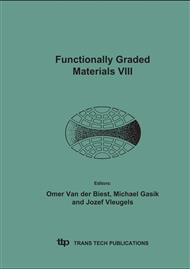p.587
p.593
p.599
p.605
p.609
p.615
p.621
p.627
p.635
Particle Distribution and Orientation in Al-Al3Zr and Al-Al3Ti FGMs Produced by the Centrifugal Method
Abstract:
Al-Al3Zr and Al-Al3Ti functionally graded materials (FGMs) were produced by a centrifugal method from Al-5wt% Zr and Al-5wt% Ti alloys, respectively. Applied centrifugal forces were 30, 60 and 120G (units of gravity). Microstructural characterization was performed to evaluate the intermetallic particles’ distribution and orientation. Knoop hardness tests were carried out, with the indenter’s long diameter normal to the centrifugal force direction. Both the Al3Zr and the Al3Ti intermetallic particles are platelet in morphology. These platelets tend to be oriented normal to the centrifugal force direction. Higher applied centrifugal force increases both the intermetallic platelet volume fraction as well as their orientation in the outer regions of the fabricated FGM rings. Also higher orientation and volume fraction distribution are observed in the Al- Al3Ti FGMs. Knoop hardness measurements in general follow the same trend as the intermetallic particle volume fraction for each sample.
Info:
Periodical:
Pages:
609-614
Citation:
Online since:
August 2005
Authors:
Price:
Сopyright:
© 2005 Trans Tech Publications Ltd. All Rights Reserved
Share:
Citation:


